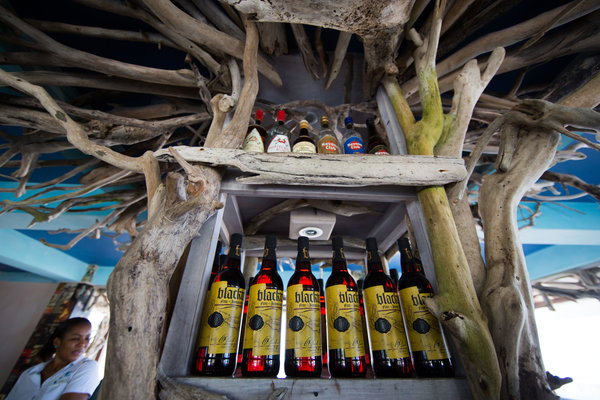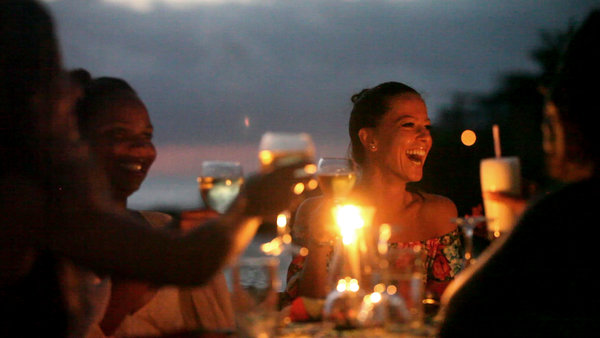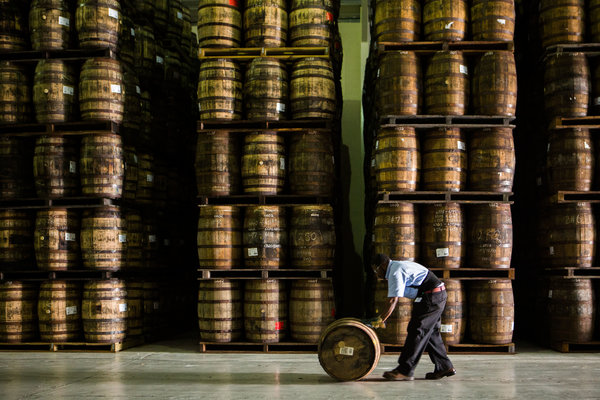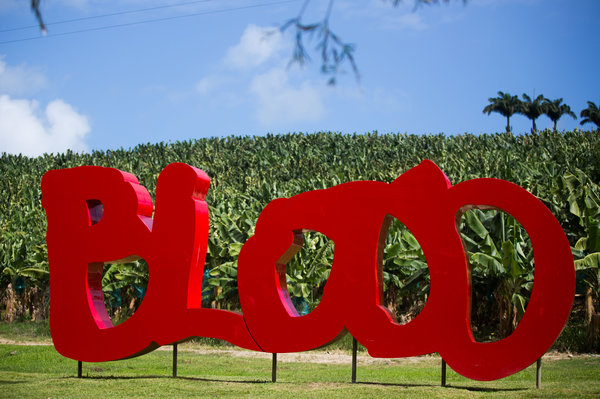
A Caribbean Rum Trail
“Care to kiss the ground?” The question came, with a slightly patronizing grin, from Norman Murray, local sage and tour guide in the rural parish of St. Elizabeth, Jamaica. “Our visitors from Europe, America — this is a holy pilgrimage for them. So, really,” he egged me on, “feel free.” Confession: I nearly knelt. After years of visiting Jamaica, I had at last landed in Appleton Estate, a centuries-old temple of sorts, teeming with spirits and nestled in the lush Nassau Valley.

Guests at Jakes hotel in Treasure Beach, Jamaica.
I composed myself, and resumed the tour, moving from fermentation to distillation to tongue-titillation — a.k.a. tasting — under Mr. Murray’s erudite command. I learned how rum was born in the 17th century, when industrial waste — molasses residue from slave-era sugar production — was transformed via yeast into drinkable stuff, marketable especially in New England, where the “spirit of ‘76” so saturated American culture that George Washington demanded it at his inauguration. I also sampled molasses, met a donkey that demonstrated old-time methods for crushing cane, discovered how rum gets flavor and color (wood-barrel aging) and recorded factors affecting the final product (soil, climate, variety of cane, strain of yeast). I heard of Joy Spence, one of the rum world’s only female master blenders (“She’s all ours!” Mr. Murray affirmed). And thus this ardent rum fan did not divert from her sober — er, sometimes sober — mission: travel the Caribbean, steered by rum.
Call it rumming around: traversing three islands via the inebriating stuff — the oil of the colonial era — that, for centuries, lubricated economies and fueled bloody deeds. This string of islands may chat in disparate tongues and dance to divergent soundtracks, but one heady draft remains its common denominator: brown or white, served neat in roadside watering holes or garnished with cherries and umbrellas in tourist spots, rum yokes the region historically, culturally, intoxicatingly.
It’s also on the rise. Much as vodka did a decade ago, rum is enjoying a resurgence, with brands emerging from Connecticut to St. Croix, Australia to Trinidad. Never mind food and wine; food and rum festivals are the way to go, in destinations like Barbados, Grenada, Berlin and Rome. The International Rum Council, an online community featuring awards, chat rooms and a visual “museum,” offers rum-themed cruises; there’s even a global National Rum Day, Aug. 16. Ah, liquor gentrification: an erstwhile low-class swill putatively named for “rumbullion,” meaning “great tumult,” nicknamed “kill-devil,” and described by a colonial visitor to the West Indies as “a hot, hellish and terrible liquor,” has turned trendy. All of which makes it the ideal chaperone through the Caribbean’s many faces: humble and haute, past and present.
I began my mission where many a mission was born: Goldeneye. On Jamaica’s north coast, the onetime home of the James Bond creator Ian Fleming is now a resort owned by the former Island Records impresario Chris Blackwell, the man who introduced the world to Bob Marley. These days Mr. Blackwell is promoting another Jamaican staple, which greeted me as I entered my swanky beachfront cottage: Blackwell Rum.

One of the Mount Gay Distillery warehouses in Barbados.
The bottle screamed “old-tyme pirate” — yellowing label, baroque lettering. I poured a glass on the rocks and savored its dense, caramel flavor.
“I drink it neat, and sometimes atop a nice fruit salad,” Mr. Blackwell said in a phone interview, adding that rum is the first venture he’s put his name on. It’s also a return to roots: Mr. Blackwell’s grandfather once ran J. Wray & Nephew, the Jamaican rum company that now owns Appleton, which makes Blackwell Rum; the younger Blackwell started a record label instead. In other words, had the rum industry been more alluring, the world might be devoid of many a reggae masterpiece.
Goldeneye, Mr. Blackwell told me, is his rum’s “spiritual home.” The place is matrix-like — a perfect marriage of barefoot funkiness (album-art walls, a soundtrack that veers from Bob Marley to U2) and elegance (a footbridge over the lagoon is torch-lit, illuminating the path to fine dining). My stay was punctuated by ordinary activities that become extraordinary at Goldeneye: transcendent outdoor showers under a half-moon; sublime swims in the lazy lagoon, escorted by flying fish and butterflies. Blackwell Rum was at the heart of it all. By day I sipped it with watermelon and ginger, meditating on the way sunlight pirouettes off a golden-eye mosaic in the pool; by night it marinated my lobster and coconut rice.
Following the rum route led south to Treasure Beach, a blissfully untouristy sliver of Jamaica where there are no all-inclusives or “yah, man” knickknacks. I checked into Jakes, a boutique hotel that’s really a band of fanciful cottages along six rocky acres — a place where your room experience hinges on the time of day: At what angle is the daylight reflecting off the blue bottles embedded in my outdoor shower? How fiercely does the sea splash on the crags of my deck this hour of the tide? In May, Jakes will stage Jamaica’s first food-and-rum festival — fitting for a property so close to the island’s spirits mecca.

Saint-James distillery on Martinique.
That mecca, the Appleton Estate, seems like a tropical mirage. Set in a luxuriant landscape — 11,000 acres of swaying sugar cane, and terrain resembling an upside-down egg carton — is cumbrous industrial equipment for producing spirits. The ultimate effect, though, elevates industry: rum as testament to human innovation. “A journey through rum,” read Mr. Murray’s tour-guide shirt, and indeed it was. Appleton dates back to 1749. In the 19th century, Jamaica became the region’s leading rum producer, famous for its so-called overproof, whose extra-high alcohol content made it easier to ship. Nowadays overproof is almost exclusively a local thing, accounting for some 90 percent of rum sales here.
“I use it,” said Mr. Murray, holding a bottle of Wray & Nephew overproof to his nose, “to clear sinuses. For headaches. And to clean my tub. Just don’t strike a match nearby when doing that.”
The climax of our tour came in a reggae-infused bar: 13 varieties for tasting, including one standout — Berry Hill, flavored with pimento.
“Don’t be shy, folks.” Mr. Murray decreed. “We’ve got more. Keep drinking!”
I did, on another island. After the rugged terrain of Jamaica, Barbados’s flatness was striking. Such topography is ideal for cultivating cane. Barbados is one of the region’s only coral limestone islands, said to lend an inimitable flavor to the water used in rum production.
I arrived in time for the annual Food & Wine and Rum Festival in November: sumptuous fêtes, rum tastings and classes by chefs like Marcus Samuelsson, Ming Tsai — and Paul Yellin, known as the Rhum Chef. Barbados-raised and author of the cookbook “Infusion! Spirited Cooking,” Mr. Yellin agreed to rum around with me on the island that boasts of having invented the stuff. This is dubious — the liquor was likely invented in many places, around the same time — but Barbados can claim one of the earliest documented uses of the word, in a 1658 plantation deed. As the onetime capital of sugar, Barbados developed a robust rum culture. One colonial settler deemed his companions “such great drunkards” that they would “buy their drink although they go naked.” I planned to remain clothed, and slightly sober. Mr. Yellin had other ideas about this last bit.
“Breakfast in one distillery, lunch in another. And definitely more rum for dinner,” he explained, picking me up in his truck after sunrise. Breakfast never made it past the car: fish cakes with tangy pepper sauce that I devoured as we traversed a cane field. We toured the Foursquare Rum Distillery and Heritage Park, a sugar plantation turned modern factory. Wandering through the Willie Wonka-like plant and grounds, dotted with guava trees and pastel lampposts, home to a “folk museum” and a gallery of outmoded sugar-production tools, Mr. Yellin noted an irony: Once rum was the extra stuff made from the real moneymaking crop, but our globalized economy turned this on its head. Sugar, no longer profitable in the Caribbean, is now a footnote to today’s cash cow: rum.
I noted another irony at Mount Gay Visitor Center, in the capital of Bridgetown and home to the brand’s bottling and final distillation process. “There’s a Time and a Place,” declared the logo upon entry, and indeed Mount Gay markets history with taste: Sir John Gay Alleyne, the company’s founder, is considered the father of Barbadian rum. After a rum punch welcome and a historical film, Mr. Yellin suggested we get right down to what the cruise-ship hordes come for: tastings.
All Mount Gay rums, I learned, are blends of distillates and none are age-specified — “it’s ready when its ready,” goes the logo. Rum matures faster than whiskey; unlike wine, it stops aging once it leaves the barrel. At the aroma bar, stooping before scented bowls, I learned what to taste for, in Mount Gay brands I’d never seen in an American bar: banana, almond, vanilla. The brand’s newest debut became my favorite: Black Barrel, finished in charred bourbon oak barrels. Here lies a delectable flavor that’s fruity, spicy, peppery — alcoholic fruitcake in a snifter.
But back to that irony. It hit me after our on-site lunch and dessert of local chocolate (accompanied by rum, naturally), as we passed through the rum museum honoring Bajan activities and events that go well with Mount Gay: domino-playing, sailing and Crop-Over, a festival once marking the end of the cane-harvesting season, now the island’s annual carnival. Ogling the extravagant costumes, I meditated on the manic-depressive vagaries of Caribbean history: a drink born in suffering — on the backs of slaves — is born again as fuel for an exultant, life-affirming ritual.
Irony intensified as Mr. Yellin and I made our way up the well-heeled west coast, past Sandy Lane, home to an upscale hotel and Barbados’s unofficial tourist attraction: Rihanna’s gazillion-dollar mansion. Through flocks of children in smart school uniforms, we reached the rural north and landed in the colonial Caribbean — St. Nicholas Abbey, 400 acres of cane fields, mahogany forests, mango trees and a Jacobean mansion built in 1658. From drawing room to dining room, slave records to family tree — one owner, John Yeamans, bears the ignoble legacy of having introduced slavery to the Carolinas — the place was hauntingly immaculate. So was its namesake rum, produced on-site in a mini-distillery. I tasted three varieties and decided the pepper rum, for seasoning, was quite the treat. Mildly tipsy, I walked the grounds. Cane reached clouds; the sun set crimson. It all seemed like a movie set: old sugar mill, sapphire sky, eerie calm. This beauty confounded me: How to juxtapose it with the dastardly deed at its core?
Such is the reality of Barbados’s past. It’s said that 17th-century Bridgetown boasted one “tippling house” per 20 residents; nowadays the number of rum shops dotting the island is disputable, but all agree on one answer: many. Between swim stops at spectacular beaches, I drove through countryside populated by small chattel houses, testing bar stools from one end of the island to the other. My haunts bore names like De Nest Bar and Hide Away, Survival Bar and Marshall’s — the latter owned, naturally, by Marshall, brother to a cricket player whose photo adorns the bar. One had a sign reading, “abusive language not allowed”; another had room for just a single stool; all were populated by motley regulars, debating elections and cricket in the same breath. On the Atlantic side I relished Bathsheba, where the views become cliffside dramatic. There I drank Mount Gay and coconut water with an eye on the frothy sea. Next thing I knew I was dancing to soca music in a rum shop just past the barber shop, to the left of the roundabout; then I was dancing while devouring something heavenly called “pickled seacat,” which is actually a ceviche of octopus.
Just when I thought I had a handle on rum, I discovered rhum. Enter Martinique, elegant French island, home to cane and banana fields, a hikable volcano, black-sand beaches — and a nationalistic, revisionary rum legacy.
I was schooled during a tour of La Favorite, near the island’s capital, Fort-de-France. There are 11 distilleries on the island, seven still producing rum. La Favorite, one of two family-owned ones, exhibits a 1905 steam engine, still powering the whole shebang, in a humble factory that looks, from the visitor’s trail above, like the inside of a grand old clock. A defining feature of all Martinican distilleries stands nearby: a distillation column, cap made of copper, as per regulation. Regulation? Indeed: from the French government, which granted Martinican rum the Appellation d’Origine Contrôlée, or AOC: a designation given to fine agricultural products like cognac and cheese. This means that La Favorite is governed by exacting protocols about such things as permitted cane (only 12 varieties, to be cut and crushed on the same day) and aging process: white rum ages at least eight weeks in metal vats; dark rum, 12 to 18 months in oak barrels; rhum vieux, old rum, a minimum of three years.
I explained to my guide that I was familiar with the production process, having just come from Jamaica and Barbados. Grand faux pas.
“Madame,” Emmanuelle said. “They make rhum industriel in those islands. Only the French make our rum — the rhum agricole.”
Ah, oui, oui, I reassured her. Rhum agricole, like Brazilian cachaça, is made not from molasses but the cane juice itself, which the French tell us is truer to the sugar flavor.
(“Rhum industriel? Ha!” Mount Gay Ambassador Chesterfield Brown had muttered during his tasting session at the Barbados Food & Wine and Rum Festival. “There’s nothing industrial about our rum.”)
In the end, it’s a matter of taste. Distinguished by alcohol level, color, age and, like wine, terroir, rhum agricole is earthier than my beloved Appleton. The whites had a sweet, flowery flavor; the extra-olds, unique vintages, evoked maple and coffee.
But in Martinique the taste of the rum was beside the point; the distillery was everything. Rum touring in Martinique rivals Napa wine jaunts.
I crammed six tours into three days. On the rugged Atlantic side — crossing rivers and bridges, past E.U. flags and through South of France-style villages — there was Rhum JM: all sleek lines and green tiles and modish tasting bar lit by straw chandeliers. Nearby Saint-James, the biggest, was overrun by French tourists lining up for rides through the cane fields on a Disneyesque “sugar train.” In its museum in a 19th-century Creole house, I pondered rum’s iconography: old ads depicting happy plantations with cheerful slaves, women with madras headwraps and seductive smiles. My musings led to a dialogue with Michel Fayad, distillery manager and former history teacher.
“Our whole history is wrapped up in this alcohol,” he said. “But what is it? Depends who you ask, yes? For the European visitors, it’s holiday. To the bekes” — white Martinicans, colonial descendants who still run the bulk of the island’s economy and all but one of its distilleries — “rum is pride. To blacks, locals, it’s also colonialism, slavery, alcoholism, sadness. We drink Champagne at weddings. Rum is for funerals.”
On the west coast, in the village of Le Carbet, is petite Neisson, where cane is cut by hand, and the mother-and-son team who run the place served up the ultra-crisp L’Esprit.
Then, past patisseries and roadside jus de cane stands, I landed in edenicDepaz, in the foothills of Mount Pelée, the volcano whose 1902 eruption turned the city of St. -Pierre from the Paris of the West Indies, as the bustling port was known, to its Pompeii. I’d been gawking at Mount Pelée since I arrived, but it played hide-and-seek behind clouds. At Depaz I stood beside it — fully, gloriously in view. A stroll through the property had me feeling like Alice in Wonderland: the Caribbean beckoned on one side, cane fields on the other; crowning it all was Le Château Depaz, a Gatsbyesque mansion rebuilt from volcanic stones by Victor Depaz — called mad for setting up shop on the doorstep of a volcano that had only just spewed lava, ruining the old estate and leaving a lone survivor, a prisoner in the underground jail, serving eight days for a drunken brawl and thus said to have been saved by — what else? — rum.
On the final day of my journey, even my morning coffee was rum. Well, rum cream, consumed at Habitation Clément, a plantation with botanical gardens, a Creole house and an art gallery. The flavors and blends sold alongside traditional Clément rums are dazzling: coffee, chocolate, mojito, coconut, guava, cherry.

“Blood,” a sculpture by Thierry Alet, 2011, at Habitation Clément, meant to evoke the dark side of cane production
But during an audio tour that thoroughly covered rum history and production — maps, diagrams, photo exhibits, French-accented voice-overs — I decided that here lay the educational apex of distillery-hopping. I wandered through the plantation’s sculpture garden and, reflecting on the legacy of the liquid I’d been trailing, spotted something remarkable: blood on the leaves. A massive red statue of the word “Blood,” poised before a picture-perfect cane field. It evoked, of course, the Billie Holiday song “Strange Fruit,” about lynchings in a pastoral Southern landscape: “Blood on the leaves and blood at the root,” she sang. This scene, stunning yet haunted by perennial pain, struck me as perfect homage: Behold a spirit whose legacy contains all the paradoxes and complexity of the wistfully beautiful region that gave birth to it so long ago.
IF YOU GO
History
These books are excellent sources on rum and its history.
“And a Bottle of Rum: A History of the New World in Ten Cocktails,” by Wayne Curtis
“Rum: A Social and Sociable History of the Real Spirit of 1776,” by Ian Williams
Accommodations
Chic beachfront and lagoon cottages, a stunning villa where Ian Fleming once lived, delectable and locally sourced menus, staff that treats you like an old friend: Goldeneye (Oracabessa, Jamaica; goldeneye.com) is fabulous enough to please 007 himself.
Jakes (Calabash Bay, Treasure Beach, Jamaica; jakeshotel.com) is a boutique beachfront hotel that not only has a whimsical style but is deeply involved in local community work, through its Breds Treasure Beach Foundation.
Just off St. Lawrence Gap, Barbados’s night-life mecca, the trendy Ocean Two(Dover, Christ Church, Barbados; oceantwobarbados.com) offers the best of both worlds: It’s close to the action, but elegantly tucked away on a private beach.
Martinique’s only five-star resort, Cap Est Lagoon Resort and Spa (Le François, Martinique; capest.com) has 50 chic suites in 18 Creole-style villas, and is the sort of blissful retreat one checks into and immediately dreads leaving. It’s also a sumptuous homage to rum: rum cellar, rum menu, bottles and barrels as décor and, at the Guerlain Spa, a“ti-punch treatment,” themed after the popular local drink.
Looking Ahead
The newest offerings from Jamaica come from two members of the country’s famed Marley family. Cedella and Rohan, her brother, have developed two rums, each representative of their unique personalities. Cedella’s rum, named Silver Root, is a four-year aged, smooth, clear, ultrapremium rum. Rohan’s rum, named Spiced Root, is also super premium liquid aged four years. In contrast to Silver Root, Spiced Root is a spiced rum and loaded with traditional Jamaican flavors including cinnamon and vanilla. Both rums are currently being test marketed and will be widely distributed beginning in April of this year.
By BAZ DREISINGER – NYT
Photos PIOTR REDLINSKI

Sorry, the comment form is closed at this time.